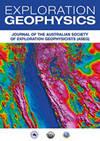变密度声波模型的等效交错网格有限差分格式及其优化策略
IF 0.8
4区 地球科学
Q4 GEOCHEMISTRY & GEOPHYSICS
引用次数: 0
摘要
与标准交错网格有限差分(FD)方法相比,等效交错网格有限差分(ESG)方法可以显著减少变密度介质中声波建模的计算内存。为了进一步提高仿真效率和精度,一种方法是优化FD系数,另一种方法是设计新的FD模板。在本文中,我们提出了一种改进的ESG (M-ESG)方案,该方案可以显著加快波场模拟过程,同时保持甚至提高建模精度。基于离散波动方程的时空色散关系,通过同时逼近时间导数和空间导数来计算FD系数。当FD系数采用泰勒级数展开(TE)方法推导时,我们在TS-D中的M-ESG方案可以保持与传统ESG (C-ESG)方案基本相同的精度。注意到C-ESG格式的TS-D色散与FD系数的关系是非线性的,因此离散波动方程的优化FD系数很难得到。然而,基于M-ESG方案,我们可以最小化色散关系的l2范数误差,实现线性FD系数优化策略,该策略简单有效。与基于TE和优化的C-ESG方案的比较表明,基于TE和优化的M-ESG方案在准确性、稳定性和效率方面具有优势。本文章由计算机程序翻译,如有差异,请以英文原文为准。
A novel equivalent staggered-grid finite-difference scheme and its optimization strategy for variable-density acoustic wave modelling
Compared with the standard staggered-grid finite-difference (FD) methods, equivalent staggered-grid (ESG) ones can significantly reduce the computational memory for acoustic wave modelling in the variable-density media. To further enhance the simulation efficiency and accuracy, one way is to optimize the FD coefficients, another way is to design new FD stencils. In this paper, we propose a modified ESG (M-ESG) scheme which can significantly accelerate the wavefield simulation process while preserving or even improving the modelling accuracy. We calculate the FD coefficients by approximating the temporal and spatial derivatives simultaneously based on time–space domain (TS-D) dispersion relation of the discrete wave equation. Our M-ESG scheme in the TS-D can maintain basically the same accuracy as the conventional ESG (C-ESG) one when the FD coefficients are derived by the Taylor-series expansion (TE) approach. Note that the TS-D dispersion relation is nonlinear with respect to the FD coefficients of the C-ESG scheme, so it is difficult to obtain the optimized FD coefficients for the discrete wave equation. However, we can minimize the L2-norm error of the dispersion relation based on our M-ESG scheme to implement a linear FD coefficients optimization strategy, which is easy and efficient. Comparisons with TE- and optimization-based C-ESG schemes demonstrate the accuracy, stability, and efficiency superiorities of our TE- and optimization-based M-ESG ones.
求助全文
通过发布文献求助,成功后即可免费获取论文全文。
去求助
来源期刊

Exploration Geophysics
地学-地球化学与地球物理
CiteScore
2.30
自引率
0.00%
发文量
33
审稿时长
>12 weeks
期刊介绍:
Exploration Geophysics is published on behalf of the Australian Society of Exploration Geophysicists (ASEG), Society of Exploration Geophysics of Japan (SEGJ), and Korean Society of Earth and Exploration Geophysicists (KSEG).
The journal presents significant case histories, advances in data interpretation, and theoretical developments resulting from original research in exploration and applied geophysics. Papers that may have implications for field practice in Australia, even if they report work from other continents, will be welcome. ´Exploration and applied geophysics´ will be interpreted broadly by the editors, so that geotechnical and environmental studies are by no means precluded.
Papers are expected to be of a high standard. Exploration Geophysics uses an international pool of reviewers drawn from industry and academic authorities as selected by the editorial panel.
The journal provides a common meeting ground for geophysicists active in either field studies or basic research.
 求助内容:
求助内容: 应助结果提醒方式:
应助结果提醒方式:


